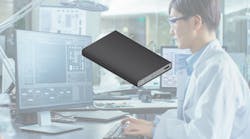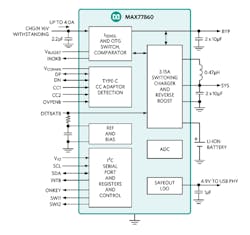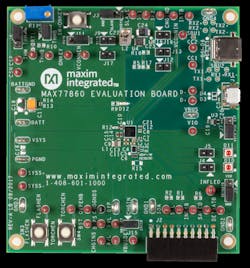USB-C Buck Charger Packs Port Controller and More in Smaller Package
The intersection of devices powered by Li-ion batteries and popularity of USB Type-C charging is driving demand for higher-performance, highly functional, yet smaller charging-related ICs. The MAX77860 from Maxim Integrated Products incorporates the critical functions and features, including what the vendor maintains is industry’s first integrated USB-C port controller and charger.
Such a configuration eliminates the need for a separate host controller to detect the current level and configure the charger’s input current limit, thus minimizing software development and trimming the subsystem BOM and costs. The MAX77860 targets point-of-sale terminals, power banks, industrial computers, scanners, radios, medical devices, charging cradles, portable speakers, and game players.
The highly efficient (up to 93%) MAX77860, a 3-A switched-mode buck charger, integrates USB-C configuration-channel (CC) port detection and a battery charger for 15-W applications, supporting battery charging at the fastest rate possible under the USB-C specification. The charger features a single input which works for both USB and high-voltage adapters. The CC pin-detection feature removes the requirement to support end-to-end USB port connection and allows charging to start automatically.
A highly integrated power device, the MAX77860 includes many USB-C functions and features (Fig. 1). The I2C-compatible (3.0) interface, with bidirectional serial data line (SDA) and a serial clock line (SCL), eases connection to the host processor.
1. The MAX77860 3-A switched-mode buck charger integrates USB-C configuration-channel (CC) port detection and a battery charger for 15-W applications.
This single-input switch-mode charger includes:
- Up to 14-V protection
- 4.0- to 13.5-V input operating range
- Switching charger with D+/D- charger detection
- Up to 4-A input-current limit with adaptive input-current limit (AICL)
- Up to 3.15-A battery-charging current limit
- Optional external sense resistor
- CC, CV, and die-temperature control
- Supports USB-OTG reverse boost, up to 1.5-A current limit
- Master-slave charging capability, up to 6-A charge current
- Integrated battery true-disconnect FET
- Rated up to 9 ARMS, with programmable discharge current limit
Its USB Type-C detection includes:
- Integrated VCONN switch
- CC pin
- D+/D- detection for USB HVDCP
- BC 1.2 support
The MAX77860 comes in a 3.9- × 4.0-mm, 81-bump, wafer-level package and is priced at $3.03 (1000-piece lots). With so many functions packed into the IC, an evaluation board makes sense: The MAX77860EVKIT ($70) is a ready-to-use PCB for the MAX77860 supported by Windows-based GUI software (Fig. 2). Among other features, it demonstrates operation over the full input-operating range, USB Type-C charging up to 3.15 A, adapter detection, and USB-OTG functionality.
2. A ready-to-use PCB, the MAX77860EVKIT, features Windows-based GUI support.



